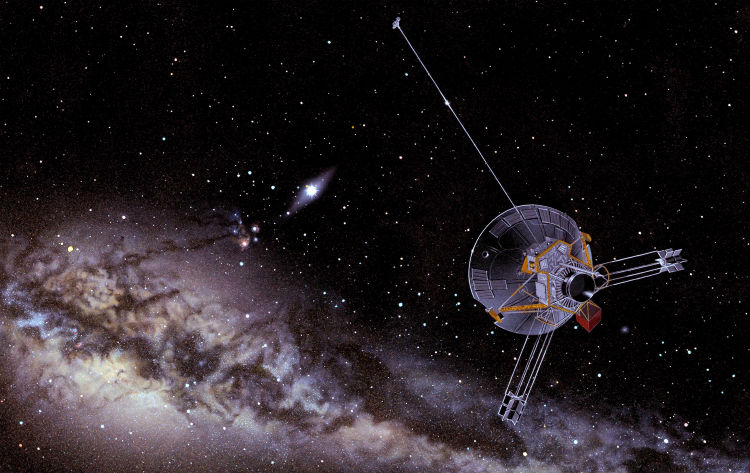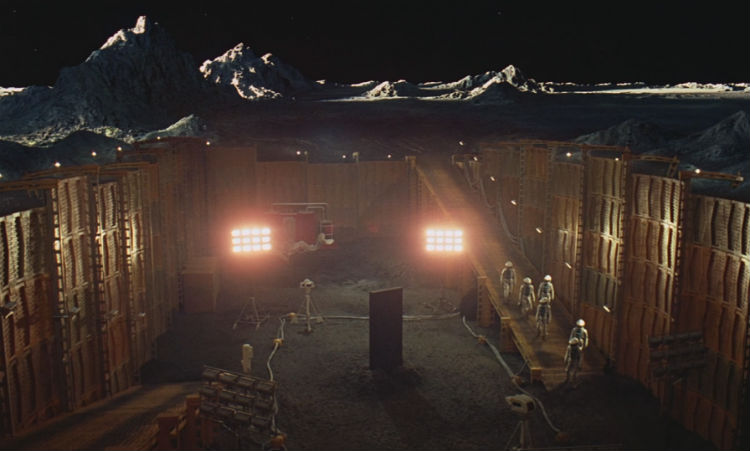One of the more profound questions we're confronted with when pondering the cosmos relates to our identity as human beings. We consider this question every time we encounter ourselves in relation to the bigger picture of the cosmos: are we alone in the galaxy?
It would seem, given the hundreds of billions of star systems in the Milky Way, that our galaxy should be teeming with life. So far, our observations would seem to suggest otherwise.
I've previously written about the concept of using self-replicating von Neumann Machines for space exploration, and reasons why we haven't seen any alien ones yet. Are we actually alone in the galaxy? Or could an advanced alien civilization be out there, and not yet detectable with our current technological capabilities?
In any case, it's logical to assume that any advanced alien civilization that may exist would probably utilize some form of self-replicating machines as a way to achieve a number of different tasks throughout the galaxy and beyond. These tasks may be as simple and beningn as exploration and discovery, as complex as building megastructures around stars, or as nefarious as attempting to eradicate all life in the galaxy.
Here seven possible types of von Neumann machines that could be utilized by a technologically advanced galactic civilization:
1. Exploration Probes
2. Automated Biologists/Zoologists
3. Life Seeders
4. Communications Relays
5. Manufacturers
6. Berserkers
7. Civilization Uplifters
1. EXPLORATION PROBES

If information is the currency of our modern age, then scientific achievement is its Gross Domestic Product. We currently spend billions of dollars every year designing and building robotic probes for very specific tasks exploring our own solar system. These range from: studying the geological history of Mars (Curiosity and Exomars), examining the inner composition of Jupiter (Juno), getting the first up-close observations of Pluto (New Horizons), and investigating the properties of both comets (Rosetta and Philae) and asteroids (Dawn and Hayabusa 2) alike.
Future missions will become increasingly ambitious. NASA wants to send humans to Mars. Most other countries want to establish a human base on the Moon. And there are plans to send increasingly capable robots in search of signs of life on Mars and Europa.
In a distant future where we've explored every corner of our solar system, we'll move on to interstellar targets—eventually, the entire galaxy. And with a fleet of self-replicating machines capable of exploring the cosmos autonomously and efficiently, it would only take a few million years to explore the hundreds of billions of stars and planets in our entire Milky Way Galaxy.

With self-replicating machines proliferating throughout the galaxy, an advanced civilization could measure the temperature and energy potential of every star, accurately calculate the total mass and age of every star system, determine the orbital characteristics and habitability of every planet, analyze the chemical composition and distribution of elements through the entire galaxy, and so on, ad infinitum.
Armed with all of this information, a civilization could achieve absolute mastery over an entire galaxy's worth of resources. Such a civilization would be able to look into the far future, predict the evolution of the galaxy's star population (and eventually do the same for neighboring galaxies), and would be able to discover avenues for future prosperity.
For any sufficiently advanced civilization, whole stars are re-appropriated for use as engines in the continued expansion and development of a galactic civilization, and entire planets become raw materials. If such an enormously powerful civilization were to arise, humanity would likely garner the same amount of respect from such a civilization as an anthill does from most people. And that may not be to our advantage if we do encounter these probes...
2. AUTOMATED BIOLOGISTS / ZOOLOGISTS

Compared to many other scientific disciplines, biology is a relatively new subject area. The theory of evolution wasn't formulated until the late 19th Century, and this scientific concept has come to dominate (and polarize) our entire way of thinking in all facets of human civilization.
Biological processes are complicated, the history of evolution is a mess, and we still can't answer the most basic questions about the origins of life: why does life exist at all? Does life arise often, or is it a rare event? Does microbial life always progress to create more complex lifeforms? And what is life, anyways?
Whereas scientists have an idea of what the distant future of physics might look like and how key cosmological questions may one day be answered, biology is still an open-ended question. Life is complicated. And even a technologically advanced alien civilization may be just as dumbfounded and curious about the origins of life as we are today.

From the perspective of a galactic civilization, one of the best ways to study the emergence of life in the cosmos would be by taking samples. Lots of samples. Having billions of self-replicating machines equipped with an artificial intelligence that specializes in biochemistry would be the most efficient way of studying life in the cosmos. These could be designed to seek out a variety of different forms of life, whether carbon-based like we have on Earth, or exotic extremophiles thriving in unexpected places. Having a large sampling of life forms across the galaxy would enable alien scientists to answer deeper questions about the nature of life in the universe.
With this system of self-replicating machine biologists, samples of fairly intelligent lifeforms (for example, humans) would be most prized of all. And if this hypothetical galactic civilization does exist, they may already have a few human beings in a galactic zoo somewhere, or in a galactic laboratory undergoing rigorous intelligence tests not unlike what we subject some animals to today.
And since it appears that cross-species communication is incredibly difficult, if not outright impossible, having facilities in place to meticulously study various forms of intelligent life may prove particularly important to an inclusive galactic civilization (that is, a civilization composed of many cooperating species, perhaps similar to the Federation of Star Trek).
But in case co-existing with a diverse range of alien species proves too difficult, an emerging galactic civilization may look to biologically engineer alien lifeforms instead. Maybe that's even how life on Earth came to be...
3. LIFE-SEEDERS

As I mentioned above, the origin of life is still a mystery—we don't know how or why life began at all. For all we know, it could have been the work of... Aliens!
Or, more specifically, it could have been the work of automated, self-replicating machines designed to seed specifically engineered lifeforms throughout the cosmos (it would be a lot of work for real aliens to travel to billions of planets dropping off primitive lifeforms. Better to send a probe that's capable of 3D-printing biological organisms).
Two possibilities could drive such an action:
- option a) life is common throughout the galaxy, but the incredibly diverse range of aliens that inhabit it have no way of getting along nor communicating with one another (and certain kinds of intelligent life may be inherently hostile no matter what). Therefore, a homogenized galactic civilization of similar lifeforms would be vastly preferable to a haphazard melting pot of incompatible civilizations. As a result, alien civilizations are encouraged to seed a specific kind of life (carbon-based, such as ourselves), in the hopes that future intelligent species similar to themselves might emerge. Or,
- option b) life, especially of the intelligent variety, is very rare in the cosmos. Therefore, an advanced civilization may find itself alone in the cosmos and begin to view the propagation of life as the ultimate purpose of existence, both for the cosmos and for life overall. As a result, seeding biological lifeforms throughout the universe may become the central goal of such a civilization (and in case they want to double-dip, later on they can send biologist probes to collect samples for their galactic zoo collections!).
Alternatively, these probes could work primarily as 'terraforming' devices, preparing new worlds for future colonists from the alien homeworld. This could be achieved by seeding specific biological lifeforms that would give rise to the ideal conditions for life to flourish (for example, terraforming Mars may require us to deliver engineered organisms capable of using photosynthesis to create oxygen for us to breathe).
The result of this is that, rather than being a big unlikely accident, life on Earth—and perhaps even human life—may have been purposefully engineered by alien probes many millions or billions of years ago. This could pose even more questions about our origins: why would this advanced alien civilization choose to seed life on Earth, and where are they now?
4. COMMUNICATIONS RELAYS

With information as the currency of any sufficiently complex civilization, communication is its means of transaction. As a civilization becomes more technologically advanced, communication may become important to continued growth as a way of managing increasing complexity.
A natural extension of our Earth-based internet will be an internet that encompasses our entire solar system. And after that, as we begin traveling to other stars, we're going to want a galactic internet.
NASA already employs a deep-space network of communications relays that can keep track of its various probes—scientific and telemetry data flows downstream, while new commands flow upstream and instruct the probe on what to do next. This is how we get spacecraft to their destinations and return awesome photos of other worlds: through the deep-space internet!

A galactic civilization will probably do the same, but on a much larger scale. They won't just want a standard 3G space network. They'll want the fastest internet possible, so that colonists on frontier worlds can stream HD Netflix from the homeworld at the speed of light (or faster?).
Establishing such a network would require a significant amount of galactic infrastucture, and a massive number of self-replicating communications machines would be required in order to sustain a fast connection across cosmic distances. Because it would be extremely inefficient to launch communications relays from a central location, it makes far more sense to have a large number of autonomous von Neumann machines capable of expanding across the galaxy without the need for much oversight. This would work sort of like our communications satellites in Earth orbit where, instead of having to continually launch new ones, we had smart satellite that could simply make copies of themselves whenever necessary—only in this case, it would be on a galactic scale.
As it turns out, this would also become the ideal way to both communicate with (if that's even possible at all) and monitor an emerging technological civilization such as our own. By intercepting our broadcasts and one day making direct contact, having this galactic internet in place would represent an ideal, non-intrusive method of establishing communications with a neighboring civilization.
A built-in functionality of this galactic internet may be a sort of skills-testing intelligence test. Sort of like the Prime Directive in Star Trek, a galactic civilization may have a non-interference clause in its constitution, requiring that any newly discovered civilization is able to both detect their galactic network and figure out a way to make contact on their own, without interference. It's only upon making contact that the galactic civilization becomes free to get involved in the affairs of the contacting civilization.
Sort of like giving a toddler the remote and telling them they can watch TV if they can figure out how to turn it on and find a channel, this could explain why we haven't detected aliens yet. We're still too infantile to even understand that TV exists, let alone realize that we can access such a thing.
But even if this is the case and we're just infants trying to figure out how to work a galactic TV, there may be other ways to find aliens. We just need to look for their gigantic engineering projects.
5. MANUFACTURERS

Large-scale engineering projects will probably become commonplace for galactic civilizations. And by large scale, I mean absolutely massive. With enough self-replicating worker machines, a civilization would be able to utilize the resources of an entire solar system in order to create giant structures, including ringworlds, Dyson spheres, and Dyson swarms.
With the recent discovery of Tabby's star, we may have already detected signs of massive alien engineering projects in our galactic neighborhood. A fleet of probes beginning the construction of something like a Dyson swarm may just perfectly fit in with the strange transit events observed at KIC 8462852. But more data is needed before we leap to conclusions here...
Even so, the premise is sound. An advanced civilization wouldn't bother using expensive physical labor to build something like a Death Star. Instead, they could just send one self-replicating machine out to a distant star system with little more than a blueprint of what they wanted built—whether it be a gigantic space station or a star-encompassing megastructure—and that single machine would be able to create thousands of replica machines that could get to work.
To put this idea in perspective, the main technological barrier to achieving such a feat is the accuracy and capability of 3D-printing technology. But once 3D-printers are able to manufacture equally-capable 3D-printers, ad infinitum, nothing would stop self-replicating machines from constructing almost anything. When it comes to manufacturing, machines autonomously building more autonomous machines is the pinnacle of efficiency—it just doesn't get any better.
Of course, such efficiency could also become dangerous. What if a fleet of self-replicating machines fell into the wrong hands, and some malevolent individual built a prototype war machine (similar to our modern day war drones) whose sole purpose was to destroy and cannibalize other technological creations and civilizations while building an infinite number of copies of itself? This type of nefarious activity could potentially become a big problem for any advanced civilization.
6. BERSERKERS

While some galactic civilizations may be benevolent and life-revering, some may also become xenophobic. Perhaps due to some observation (such as seeing evidence of advanced hostile aliens in distant galaxies) or some prior interaction (such as encountering said dangerous civilization), a galactic civilization may find it preferable to simply destroy any emerging technological civilizations before they're able to become a threat.
This may be a viable policy for perpetuating the sovereignty of any given galactic civilization. Rather than enabling competition or destabilization to emerge, it may even be ethically imperative to eradicate these younger civilizations before they become too dangerous (a galactic civilization consisting of trillions of individuals may think it morally justified to eradicate one planetary civilization of a few billion individuals in order to avoid an armed conflict that could cause the deaths of several billion more).
The best way to handle this would be autonomously, as it would eliminate the uncertainty of sending moral individuals to commit what would essentially be genocide. With a horde of self-replicating machines designed to seek-and-destroy any undocumented fledgling civilization they may encounter, all of the dirty work would be taken care of by robots.
As a secondary purpose, these berserker probes could also serve as guardians or a sort of galactic militia—if a conflict breaks out in some unruly region, having a fleet of self-replicating war machines ready to intervene would be useful. Also, the threat of hostile invaders from another galaxy could be somewhat mitigated by having an army of purpose-built war machines able to mount a defense.
This sort of system would be a natural progression from the drones we use on 21st Century battlefields today. Rather than putting human pilots in danger, we arrange it so that drone pilots can conduct operations from thousands of kilometers away, sitting in front of a computer screen. The next step here would be having fully autonomous drones that could eliminate the possibility of human error altogether, making decisions independent of human inputs.
And if you think we're in the clear because these berserkers haven't shown up to attack Earth yet, don't get ahead of yourself. Our civilization has only been detectable to any of our galactic neighbors for a very short period of time—perhaps a few decades to any alien civlization within a few light years of Earth. It would probably take some time for Earth to be detected by a civilization situated hundreds or thousands of light years away.
What this means is that these berserker war machines could be en route at this very moment. Or they may not even know about us yet, and it could take them quite some time to catch on to our existence. The problem here is that we just don't know, and all we can do is hope that any galactic civilization that does exist is a benevolent one rather than a xenophobic one.
7. CIVILIZATION UPLIFTERS

What if life is common throughout the cosmos, but intelligent life is scarce? In that case, a life-seeder would not be unnecessary, because life would already be everywhere. Further, a communications relay designed to enable first contact would be equally unnecessary, because almost no life-bearing worlds would ever give rise to a technological civilization.
In this case, a galactic civilization may want to build a probe capable of transforming non-technological lifeforms into complex technological civilizations. That is, if they've benevolent enough to forego the use of a fleet of berserkers...
An example of an uplifter can be seen in one of the most famous films of all time: Stanley Kubrick's 2001: A Space Odyssey. In this film, an alien monolith arrives on Earth and intervenes in the evolutionary trajectory of our pre-human ancestors. Fast forward to the year 2001, and human civilization has become a budding space-age civilization that's on the brink of moving out into the cosmos and becoming an interstellar civilization, at which point they find an alien machine buried on the Moon.
In this strange situation, human civilization would owe its entire existence to the influence of some mysterious alien artifact that intervened in the natural progression of life on Earth. Without the influence of this device, humans may have remained more ape-like and our current level of technological ability may never have been achieved.
But why build such a probe at all? Would it be for some benevolent purpose, like British colonialism bringing "civilization" to the "savages?" Or would it be for a more self-serving colonial purpose? Or merely for establishing a galactic Federation of worlds? Or all of the above?
To find out, we'll just have to wait and see—and keep an eye out for any mysterious objects floating incognito in our solar system.



